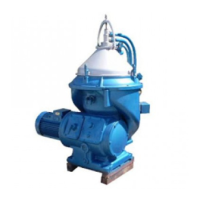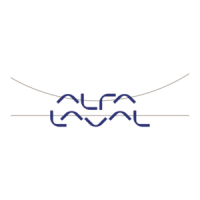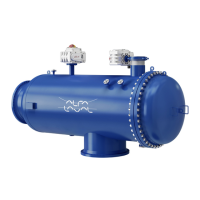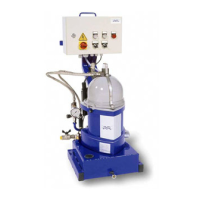Do you have a question about the Alfa Laval FOPX 610TFD and is the answer not in the manual?
Explains the fundamental concepts of liquid and solid separation.
Details the mechanical design and operational components of the separator.
Describes how power is transferred from the motor to the separator bowl.
Covers the various sensors and gauges used for monitoring the separator.
Identifies and describes the primary components involved in the separation process.
Explains the operational mechanism of the separator during the separation process.
Details the automated process for ejecting accumulated sludge from the bowl.
Provides definitions for key terms used throughout the manual.
Outlines the standard procedures for starting, running, and stopping the separator.
Provides guidance on scheduled preventive maintenance for the separator.
Specifies the recommended timeframes for various maintenance tasks.
Details the step-by-step process for performing maintenance tasks.
Lists available service kits for different maintenance levels.
Provides templates for recording maintenance activities and checks.
Lists routine checks to be performed on a daily basis.
Details the procedure and schedule for changing the lubricating oil.
Describes the tasks and requirements for intermediate service.
Outlines the procedures and components for major service.
Specifies the service requirements for the 3-year interval.
Lists specific checks to be performed during intermediate service.
Procedure for checking and replacing the bowl hood seal ring.
Inspection of the spindle cone and bowl body nave for wear or damage.
Guidance on inspecting for and addressing corrosion damage.
Instructions for identifying and rectifying cracks in components.
Method for checking and ensuring correct disc stack pressure.
Procedure for cleaning and inspecting the dosing ring.
Guidance on identifying and mitigating erosion damage.
Checking and repairing guide surfaces for burrs or galling.
Inspection of inlet pipe and oil paring disc for damage.
Procedure for removing burrs from the level ring.
Checking the lock ring for thread wear and damage.
Checking the operating mechanism for dirt and lime deposits.
Inspection of operating slide sealing surfaces and guiding surfaces.
Checking the sealing edge of the sliding bowl bottom for damage.
Procedure for checking and replacing springs in the operating mechanism.
Checking the teeth of the worm wheel and worm for wear.
Function check of the optional cover interlocking switch.
Function check of the optional vibration switch.
Lists specific checks to be performed during major service.
Checking the bowl hood seal ring during major service.
Checking spindle cone and bowl body nave during major service.
Procedure for checking and adjusting bowl spindle height position.
Measuring and checking for radial wobble in the bowl spindle.
Inspection and replacement of worn or oily brake lining.
Checking buffer springs and ball bearing housing for wear.
Checking and replacing worn or oily coupling friction pads.
Inspection for corrosion during major service.
Inspection for cracks during major service.
Checking disc stack pressure during major service.
Checking the dosing ring during major service.
Inspection for erosion during major service.
Checking the axial play of the flexible plate in the coupling.
Checking and treating guide surfaces during major service.
Checking inlet pipe and oil paring disc during major service.
Checking the level ring during major service.
Procedure for priming the lock ring threads and surfaces.
Checking lock ring for wear and damage during major service.
Checking and adjusting the height position of the oil paring disc.
Checking the operating mechanism during major service.
Checking and adjusting the height position of the operating paring disc.
Checking the operating slide during major service.
Checking the sliding bowl bottom during major service.
Checking springs for the operating mechanism during major service.
Checking the wear in the worm groove during major service.
Checking wear on worm wheel and worm teeth.
Checking for radial wobble on the worm wheel shaft.
Checking the optional cover interlocking switch during major service.
Checking the optional vibration switch during major service.
Provides essential safety and procedural guidance for lifting the separator.
Details procedures for cleaning various parts of the separator.
Instructions for cleaning the external surfaces of the frame and motor.
Information on suitable chemical cleaning agents for different parts.
Specific procedure for cleaning the separator's bowl discs.
Description of the Cleaning-In-Place system for automated cleaning.
Guidance on the process and checks related to changing the lubricating oil.
Checking the wear on worm wheel and worm teeth during oil changes.
Step-by-step instructions for performing an oil change.
Information and analysis related to separator vibration.
Methodology for analyzing and measuring vibration levels.
Details on adjusting and checking the optional vibration switch.
General guidelines and best practices for separator maintenance.
Specific instructions for maintenance and handling of bearings.
Procedures to follow before taking the separator offline for extended periods.
General information and guidelines for dismantling and assembly procedures.
Provides essential safety and procedural advice for dismantling.
Explains how to reference specific check points in other sections.
Lists the special tools required for dismantling and assembly.
Detailed instructions for dismantling and assembling the inlet/outlet and frame hood.
Diagram showing the disassembled parts of the inlet/outlet and frame hood.
Step-by-step guide for disassembling the inlet/outlet and frame hood.
Step-by-step guide for reassembling the inlet/outlet and frame hood.
Instructions for dismantling and assembling the bowl hood and disc stack.
Diagram showing the disassembled parts of the bowl hood and disc stack.
Detailed steps for disassembling the bowl hood and disc stack.
Detailed steps for reassembling the bowl hood and disc stack.
Instructions for dismantling and assembling the bowl body and operating mechanism.
Diagram showing the disassembled parts of the bowl body and operating mechanism.
Detailed steps for disassembling the bowl body and operating mechanism.
Detailed steps for reassembling the bowl body and operating mechanism.
Instructions for dismantling and assembling the operating water device.
Diagram showing the disassembled parts of the operating water device.
Detailed steps for disassembling the operating water device.
Detailed steps for reassembling the operating water device.
Instructions for dismantling and assembling the vertical driving device.
Diagram showing the disassembled parts of the vertical driving device.
Detailed steps for disassembling the vertical driving device.
Detailed steps for reassembling the vertical driving device.
Instructions for dismantling and assembling the horizontal driving device.
Diagram showing the disassembled parts of the horizontal driving device.
Detailed steps for disassembling the horizontal driving device.
Detailed steps for reassembling the horizontal driving device.
Troubleshooting guide for mechanical issues of the FOPX separator.
Diagnosing and resolving issues related to separator vibration.
Identifying potential causes for unusual smells during operation.
Troubleshooting common sources of noise from the separator.
Diagnosing reasons for the separator operating at insufficient speed.
Addressing issues where high power is consumed during start-up.
Troubleshooting low power consumption during separator start-up.
Identifying causes for extended start-up times.
Diagnosing issues related to slow stopping times.
Troubleshooting the presence of water in the worm gear housing.
Troubleshooting guide for issues related to the separation process.
Addressing unintended liquid discharge from the bowl casing.
Diagnosing and resolving accidental bowl opening during operation.
Troubleshooting why the bowl does not open for sludge discharge.
Resolving issues related to ineffective or unsatisfactory sludge discharge.
Diagnosing and correcting poor separation results.
Addressing issues of high pressure in the water outlet.
Troubleshooting common issues with the optional vibration switch.
Resolving cases where the vibration switch fails to reset.
Troubleshooting difficulties in setting the vibration switch tripping point.
Provides detailed technical specifications for the separator.
Lists all connections with descriptions and requirements/limits.
Details the system interface, limitations, and conditions for operation.
Provides definitions for terms related to interface and operation.
Describes key components and their signal processing functions.
Illustrates the separator's operational modes and limitations.
Specifies the requirements for operating water quality.
Comprehensive guide to lubrication points and recommended lubricants.
General chart detailing lubrication points and recommended lubricants.
Lists approved lubricating oils based on ambient temperature.
Lists specific commercial oil brands recommended for use.
Lists recommended pastes and greases for various applications.
Collection of diagrams and drawings illustrating the separator.
Provides overall dimensions and key measurements of the separator.
Illustrates the dimensions and types of the separator's connections.
Guidance and drawings for preparing separator foundations.
Technical specifications and drawings for the electric motor.
Details on machine identification plates and safety labels.
Technical information for the optional vibration sensor.
Technical information for the optional cover interlocking switch.
Instructions for proper storage and installation of the separator.
Guidelines for storing and transporting the separator and its parts.
Advice on planning the installation site and space requirements.
Detailed specifications and procedures for installing the separator foundation.
Explains the fundamental concepts of liquid and solid separation.
Details the mechanical design and operational components of the separator.
Describes how power is transferred from the motor to the separator bowl.
Covers the various sensors and gauges used for monitoring the separator.
Identifies and describes the primary components involved in the separation process.
Explains the operational mechanism of the separator during the separation process.
Details the automated process for ejecting accumulated sludge from the bowl.
Provides definitions for key terms used throughout the manual.
Outlines the standard procedures for starting, running, and stopping the separator.
Provides guidance on scheduled preventive maintenance for the separator.
Specifies the recommended timeframes for various maintenance tasks.
Details the step-by-step process for performing maintenance tasks.
Lists available service kits for different maintenance levels.
Provides templates for recording maintenance activities and checks.
Lists routine checks to be performed on a daily basis.
Details the procedure and schedule for changing the lubricating oil.
Describes the tasks and requirements for intermediate service.
Outlines the procedures and components for major service.
Specifies the service requirements for the 3-year interval.
Lists specific checks to be performed during intermediate service.
Procedure for checking and replacing the bowl hood seal ring.
Inspection of the spindle cone and bowl body nave for wear or damage.
Guidance on inspecting for and addressing corrosion damage.
Instructions for identifying and rectifying cracks in components.
Method for checking and ensuring correct disc stack pressure.
Procedure for cleaning and inspecting the dosing ring.
Guidance on identifying and mitigating erosion damage.
Checking and repairing guide surfaces for burrs or galling.
Inspection of inlet pipe and oil paring disc for damage.
Procedure for removing burrs from the level ring.
Checking the lock ring for thread wear and damage.
Checking the operating mechanism for dirt and lime deposits.
Inspection of operating slide sealing surfaces and guiding surfaces.
Checking the sealing edge of the sliding bowl bottom for damage.
Procedure for checking and replacing springs in the operating mechanism.
Checking the teeth of the worm wheel and worm for wear.
Function check of the optional cover interlocking switch.
Function check of the optional vibration switch.
Lists specific checks to be performed during major service.
Checking the bowl hood seal ring during major service.
Checking spindle cone and bowl body nave during major service.
Procedure for checking and adjusting bowl spindle height position.
Measuring and checking for radial wobble in the bowl spindle.
Inspection and replacement of worn or oily brake lining.
Checking buffer springs and ball bearing housing for wear.
Checking and replacing worn or oily coupling friction pads.
Inspection for corrosion during major service.
Inspection for cracks during major service.
Checking disc stack pressure during major service.
Checking the dosing ring during major service.
Inspection for erosion during major service.
Checking the axial play of the flexible plate in the coupling.
Checking and treating guide surfaces during major service.
Checking inlet pipe and oil paring disc during major service.
Checking the level ring during major service.
Procedure for priming the lock ring threads and surfaces.
Checking lock ring for wear and damage during major service.
Checking and adjusting the height position of the oil paring disc.
Checking the operating mechanism during major service.
Checking and adjusting the height position of the operating paring disc.
Checking the operating slide during major service.
Checking the sliding bowl bottom during major service.
Checking springs for the operating mechanism during major service.
Checking the wear in the worm groove during major service.
Checking wear on worm wheel and worm teeth.
Checking for radial wobble on the worm wheel shaft.
Checking the optional cover interlocking switch during major service.
Checking the optional vibration switch during major service.
Provides essential safety and procedural guidance for lifting the separator.
Details procedures for cleaning various parts of the separator.
Instructions for cleaning the external surfaces of the frame and motor.
Information on suitable chemical cleaning agents for different parts.
Specific procedure for cleaning the separator's bowl discs.
Description of the Cleaning-In-Place system for automated cleaning.
Guidance on the process and checks related to changing the lubricating oil.
Checking the wear on worm wheel and worm teeth during oil changes.
Step-by-step instructions for performing an oil change.
Information and analysis related to separator vibration.
Methodology for analyzing and measuring vibration levels.
Details on adjusting and checking the optional vibration switch.
General guidelines and best practices for separator maintenance.
Specific instructions for maintenance and handling of bearings.
Procedures to follow before taking the separator offline for extended periods.
General information and guidelines for dismantling and assembly procedures.
Provides essential safety and procedural advice for dismantling.
Explains how to reference specific check points in other sections.
Lists the special tools required for dismantling and assembly.
Detailed instructions for dismantling and assembling the inlet/outlet and frame hood.
Diagram showing the disassembled parts of the inlet/outlet and frame hood.
Step-by-step guide for disassembling the inlet/outlet and frame hood.
Step-by-step guide for reassembling the inlet/outlet and frame hood.
Instructions for dismantling and assembling the bowl hood and disc stack.
Diagram showing the disassembled parts of the bowl hood and disc stack.
Detailed steps for disassembling the bowl hood and disc stack.
Detailed steps for reassembling the bowl hood and disc stack.
Instructions for dismantling and assembling the bowl body and operating mechanism.
Diagram showing the disassembled parts of the bowl body and operating mechanism.
Detailed steps for disassembling the bowl body and operating mechanism.
Detailed steps for reassembling the bowl body and operating mechanism.
Instructions for dismantling and assembling the operating water device.
Diagram showing the disassembled parts of the operating water device.
Detailed steps for disassembling the operating water device.
Detailed steps for reassembling the operating water device.
Instructions for dismantling and assembling the vertical driving device.
Diagram showing the disassembled parts of the vertical driving device.
Detailed steps for disassembling the vertical driving device.
Detailed steps for reassembling the vertical driving device.
Instructions for dismantling and assembling the horizontal driving device.
Diagram showing the disassembled parts of the horizontal driving device.
Detailed steps for disassembling the horizontal driving device.
Detailed steps for reassembling the horizontal driving device.
Troubleshooting guide for mechanical issues of the FOPX separator.
Diagnosing and resolving issues related to separator vibration.
Identifying potential causes for unusual smells during operation.
Troubleshooting common sources of noise from the separator.
Diagnosing reasons for the separator operating at insufficient speed.
Addressing issues where high power is consumed during start-up.
Troubleshooting low power consumption during separator start-up.
Identifying causes for extended start-up times.
Diagnosing issues related to slow stopping times.
Troubleshooting the presence of water in the worm gear housing.
Troubleshooting guide for issues related to the separation process.
Addressing unintended liquid discharge from the bowl casing.
Diagnosing and resolving accidental bowl opening during operation.
Troubleshooting why the bowl does not open for sludge discharge.
Resolving issues related to ineffective or unsatisfactory sludge discharge.
Diagnosing and correcting poor separation results.
Addressing issues of high pressure in the water outlet.
Troubleshooting common issues with the optional vibration switch.
Resolving cases where the vibration switch fails to reset.
Troubleshooting difficulties in setting the vibration switch tripping point.
Provides detailed technical specifications for the separator.
Lists all connections with descriptions and requirements/limits.
Details the system interface, limitations, and conditions for operation.
Provides definitions for terms related to interface and operation.
Describes key components and their signal processing functions.
Illustrates the separator's operational modes and limitations.
Specifies the requirements for operating water quality.
Comprehensive guide to lubrication points and recommended lubricants.
General chart detailing lubrication points and recommended lubricants.
Lists approved lubricating oils based on ambient temperature.
Lists specific commercial oil brands recommended for use.
Lists recommended pastes and greases for various applications.
Collection of diagrams and drawings illustrating the separator.
Provides overall dimensions and key measurements of the separator.
Illustrates the dimensions and types of the separator's connections.
Guidance and drawings for preparing separator foundations.
Technical specifications and drawings for the electric motor.
Details on machine identification plates and safety labels.
Technical information for the optional vibration sensor.
Technical information for the optional cover interlocking switch.
Instructions for proper storage and installation of the separator.
Guidelines for storing and transporting the separator and its parts.
Advice on planning the installation site and space requirements.
Detailed specifications and procedures for installing the separator foundation.
| Brand | Alfa Laval |
|---|---|
| Model | FOPX 610TFD |
| Category | Water Filtration Systems |
| Language | English |











